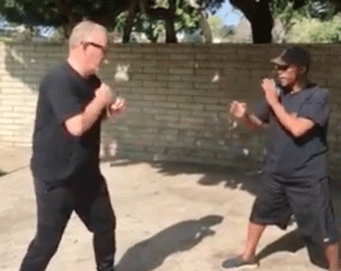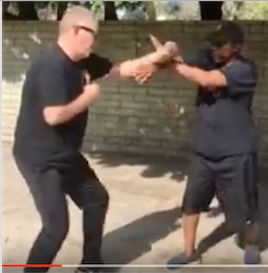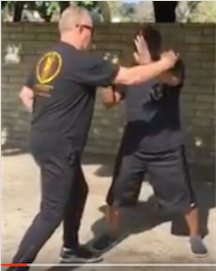The problem I was getting at was that in attempting to cover the arm on the way in, he fully extended his arm and was quite committed to following that arm back.
If suddenly a second punch comes, his response is to switch up everything entirely mid-action, including the direction he's moving.
Once body mass is already committed in one direction, with outstretched arms, it will be difficult to change footwork and everything to another direction in time.
Easy when done slowly and relaxed.
Not back away, but to the side away, which does give up distance.---The lead foot may step off to the side during the "T step" for better angling. But it is not moving back away from the opponent and giving up distance.
If his lead foot is at the center point of the circle, and rear foot along the perimeter, as he steps his lead foot to the side, and slides his rear foot backward, the whole circle, his body mass, is actually being moved away from the opponent.This is moving away from the incoming right round punch, and backward along the perimeter of the circle.
---You do realize, that since the perimeter is circular and in front of the opponent, one side of your body can move back as the other side moves forward?
He's not pivoting and using rotational force, but stepping away with both feet, taking his body mass in the opposite direction of the straight punch. Meaning it's all arm.---You pointed out yourself that the perimeter and therefore the way he is moving is circular. So if his body mass appears to swing back at one point, it is on a circular arc and is coming around to power the punch. That's how you use a "T step."

Here's the 1-2.The result is he's affording the opponent ample space to adjust and continue attacking,
---Possibly. But the whole point in flanking like this is to reach a position where it is easy for you to continue to attack but hard for the opponent to continue to attack. Just look at the awkward position his opponent would have to attack from. And one advantage to leaving this space, is that it allows space to kick, or to further adjust the angle with footwork if needed, etc.
Doesn't look awkward or difficult to attack from at all. It's a power stance with hips directed straight at him. It's more awkward for Phil to do anything from the position he put himself in, moving backward all duck footed waiting to be taken over.
If either of them are to kick, the attacker is the one with the better angle, stance, momentum, and obvious target to kick.
If the ideal is to get further around the opponent, well, it didn't even work too well in a slow demo.
What's to stop the opponent from taking advantage of it? He has not been affected in any way.And that big gap that you are seeing is very difficult for the opponent to take advantage of. And one should immediately "fill the gap" with a counter attack.
If he kept both hands up, they'd still at best be at equal advantage, or he'd be at more advantage.
He's either able to, or he isn't. And he is, so it's not really a matter of opinion., if you allow so much space, you're not really in a much safer or superior position. The opponent is still easily able to adjust and continue throwing power shots at that distance.
--I guess that's a matter of opinion! Most TWC people would disgree with you!
But as we see, nothing has been done to set the opponent up. His facing, balance, arms, or anything has not been affected. He's able to continue just the same.As you continue to block and circle away, it's just a matter of time. If you don't affect their balance or facing, just slapping at that one arm isn't going to keep you safe.
---True. But again, you don't just keep blocking and circling away. That is just to set up the opponent for your counter.
Which is obviously the main problem I have with it.TWC sometimes seems to put an over-emphasis on staying out at that middle punching range rather than just "running over" the opponent and dominating them completely!






 Reply With Quote
Reply With Quote

 "Wing Chun is a bell that appears when rung.
"Wing Chun is a bell that appears when rung.




